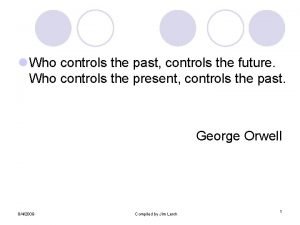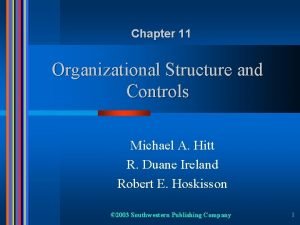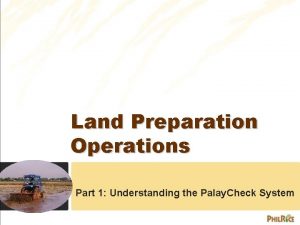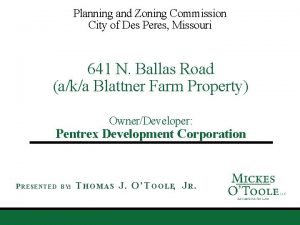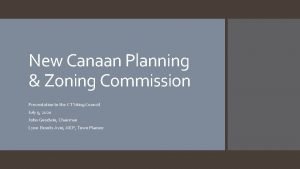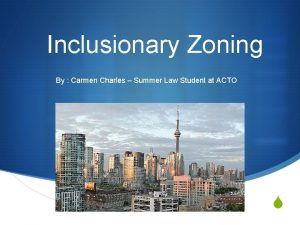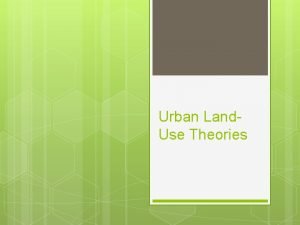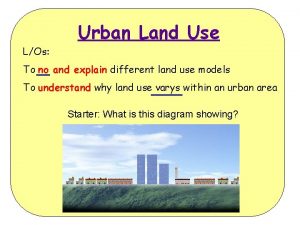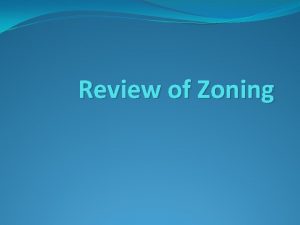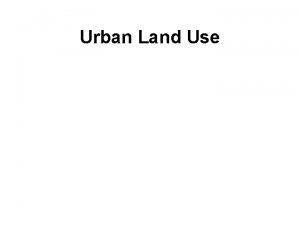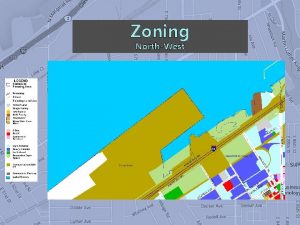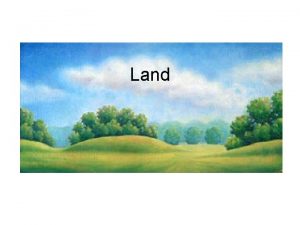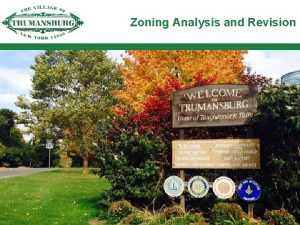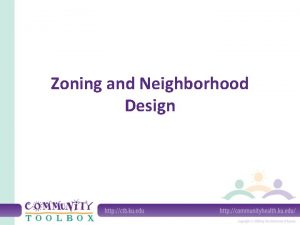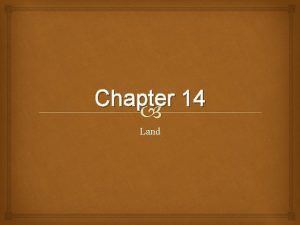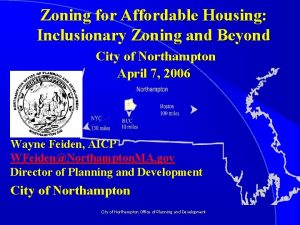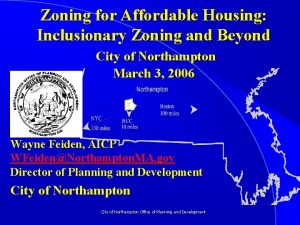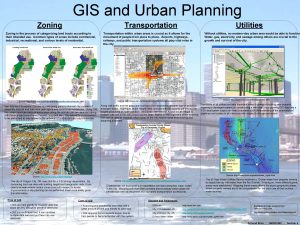Land Use Controls and Zoning Chapter 10 Why





















- Slides: 21

Land Use Controls and Zoning Chapter 10

Why do cities control land use? • Cities and government limit the location choices of residents and firms • Limit population growth to control: – Pollution – Congestion – Crime – Atmposphere

Goal of the Chapter • • Cities use land controls and zoning to: a) Limit location choices of households and firms b) Limit population growth In this chapter we address 3 questions: 1)Why do cities control land use? 2)What are the markets effects of land use controls? 3) What are the legal foundations of zoning and other land use controls?

Controlling Population Growth • Cities can limit population growth within a boundary by either using an Urban Growth Boundary or an Urban Service Boundary $ $ Business Bid Rent Residential Bid Rent SL wo RA DL u No N

Urban Service Boundary • Suppose that the City refuses to Extend Urban Services beyond X miles from city center $ SL’ SL $ w 1 wo RA DL X u N 1 No N

Urban Service Boundary (Cont) $ RA X u • As the wages rise, due to the negative shock of labor demand: a) the business bid rent function shifts to left b) the residential bid rent function shifts to the right

Who Gains and who Losses? Why? • People that own land in CBD? • People that own land in the Residential District? • People who own land outside the boundary line? • Business Firms? • Households?

Building Permits • Cities may control residential growth by issuing building permits: $ S’ $ S S P 2 P 0 P 1 D H 0 H D H 1 H

Building Permits (Cont) • Why have the costs of building a house decreased? • How should the City should allocate the permits: – H 1 Permits to be allocated – Value: H 1*(P 2 -P 1) – City must assign permits to the projects that promote their Development Strategy or by auction? $ S’ S P 2 P 1 D H 1 H

Land Use Zoning • A zoning plan designates a set of admissible land uses for each plot of lands in the city. • In theory zoning will promote health, welfare and safety by separating land of incompatible uses. • Three types of zoning: – Nuisance Zoning – Fiscal Zoning – Design Zoning

Nuisance Zoning: Separate incompatible land uses • Industrial Nuisance Zoning: Industries generate negative externalities, such as noise and air pollution. – Traditional Industrial Zoning: Exclusion from zone, reduces amount of pollution(? ) – Performance Industrial Zoning: Set limits to quantity of pollutants, efficient(? ) – Effluent taxes: Economically efficient Marginal External Cost=Effluent Fee – Spatial Effluent Fee→ Different taxes in different locations

What is more efficient? • The Effluence Fee or Zoning?

Retail and Residential Nuisance Zoning • Retail Zoning: Retail areas generate negative externalities such as traffic, noise, parking problems. – Traditional Retail Zoning: Zoning map that classifies an area as retail zone. – Performance Retail Zoning: Set upper limits for the amount of noise, odor, traffic, etc. • Residential Zoning: Residential externalities generated mostly by high-density housing. – Conventional Zoning: Exclude the project – Performance Zoning: Actual effects on the neighborhood.

Fiscal Zoning (Exclusionary Zoning) • A city excludes households that impose fiscal burdens on the local government – High Density Housing: – Who wins and who looses from High Density zoning? • • Owners of apartment land? Owners of single family housing land? Apartments owners? Single family owners? • Households living in the fringe areas of the city • New commercial and industrial development

The Tiebout Hypothesis • The Tiebout hypothesis, which states that individuals will costlessly sort themselves across local communities according to their public good preferences, is the workhorse of the local public finance literature. • Inclusionary Zoning: local developers have to build dwellings for low income households, mostly in the form of high density housings.

Design Zoning • Planner designs a city arranging activities to promote the efficient use of the city’s infrastructure – Direct development – Transferable Development Rights • Define a “Preservation Zone” and a “Development Zone” • Give some TDR to the owner of the “Preservation Zone” land, and in turn these can be sold to people in the development zone for further development.

Open Space Zoning • Should a city zone a parcel as open space and thus denying the landowner the use of her land? • Should the city purchase the land for open space?

Evenson and Wheaton (2003) • Why is this paper important? – Understand how do we organize spatially – Understand the role of government in reducing negative externalities due to imperfect assignment of property rights • Objective of the paper: – Present their dataset – establish a series of stylized facts about how do cities zone

Evenson and Wheaton (2003) (Cont) • 4 stylized facts: a) Existing density and developments are crucial determinants of zoned density and allowed development (market work) b) Future commercial development is permitted in highdensity/lower-income cities and towns c) Wealthier town more likely to set protected land aside (income is related to the extent that town allow development at all) d) No significant effect of town income on the density of future development (do not supports Tiebout Hypothesis)

Glasear, Gyourko and Saks (2003) • Goal: Analyze the effects of zoning on prices in NYC • Identification Strategy: Households buying apartments in NYC pay a Regulatory Tax that equals the difference between MC and MR (remember in perfect competition MR=MC)

Glasear, Gyourko and Saks (2003) • Main assumptions: – Marginal cost is constant and accurately calculated – Market is assumed to be in equilibrium (no demand effects)
 St mary's county land use and growth management
St mary's county land use and growth management General controls vs application controls
General controls vs application controls He who controls the past controls the future
He who controls the past controls the future Hey bye bye
Hey bye bye Briefly describe how city planners use zoning
Briefly describe how city planners use zoning An area of land largely enclosed by higher land
An area of land largely enclosed by higher land High rocky land usually with steep sides
High rocky land usually with steep sides Dont ask
Dont ask Sbu m-form structure
Sbu m-form structure Wetland preparation
Wetland preparation Zoning cons
Zoning cons Pentrex homes
Pentrex homes Washlands advantages and disadvantages
Washlands advantages and disadvantages Volusia county code enforcement
Volusia county code enforcement New canaan zoning
New canaan zoning Inclusionary zoning toronto
Inclusionary zoning toronto Baltimore county planning department
Baltimore county planning department Wakulla planning and zoning
Wakulla planning and zoning Cetacean
Cetacean Sector model theory
Sector model theory Model urband land use
Model urband land use Land use planning lecture notes
Land use planning lecture notes


